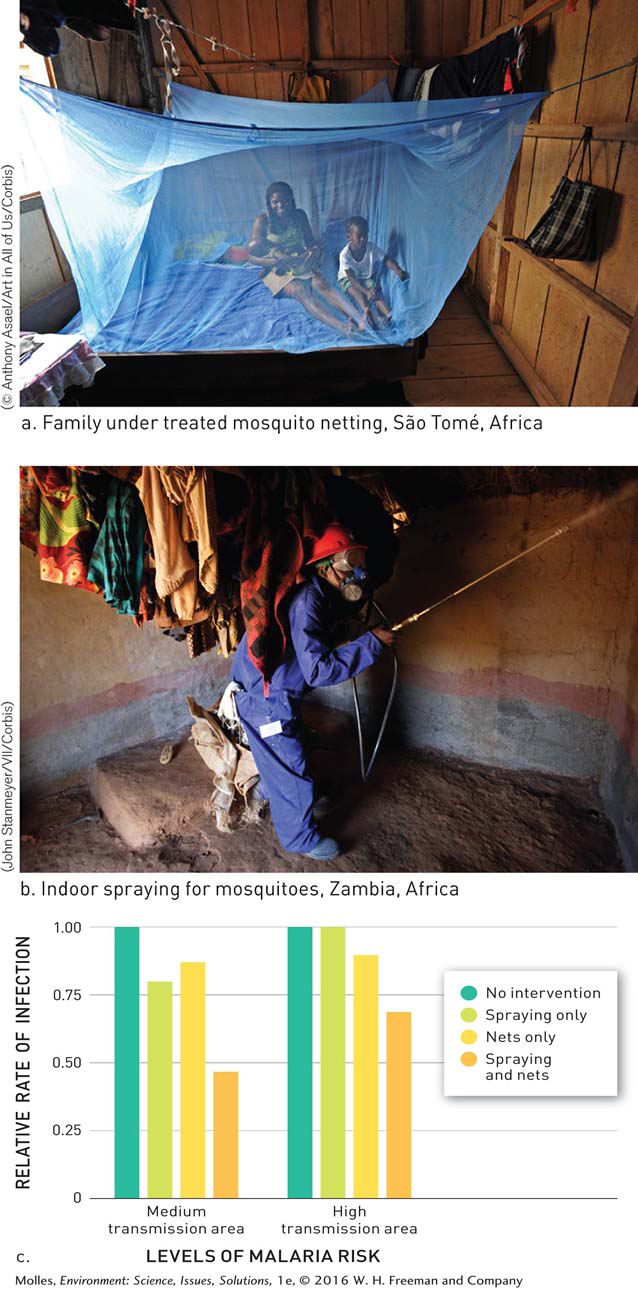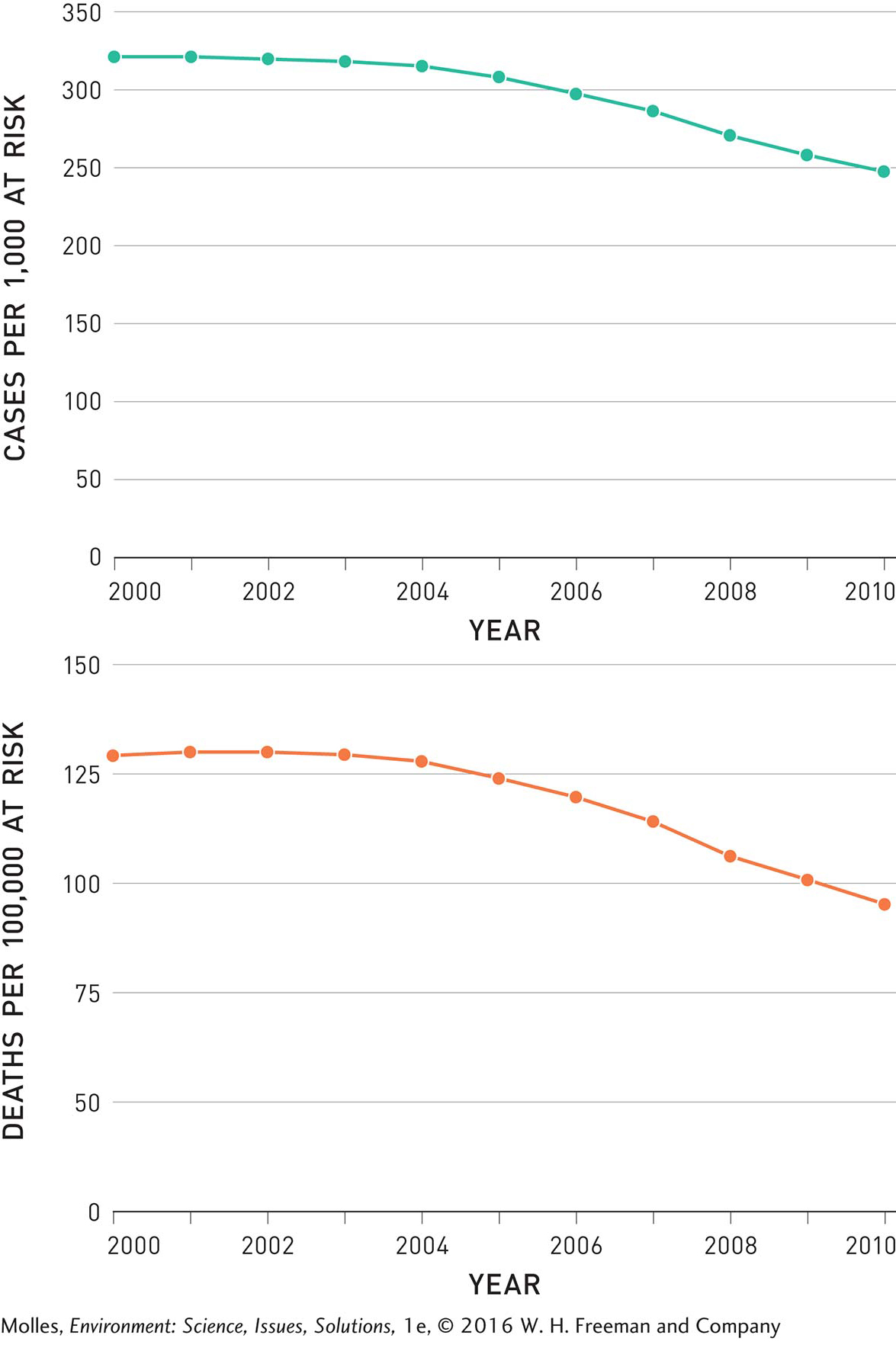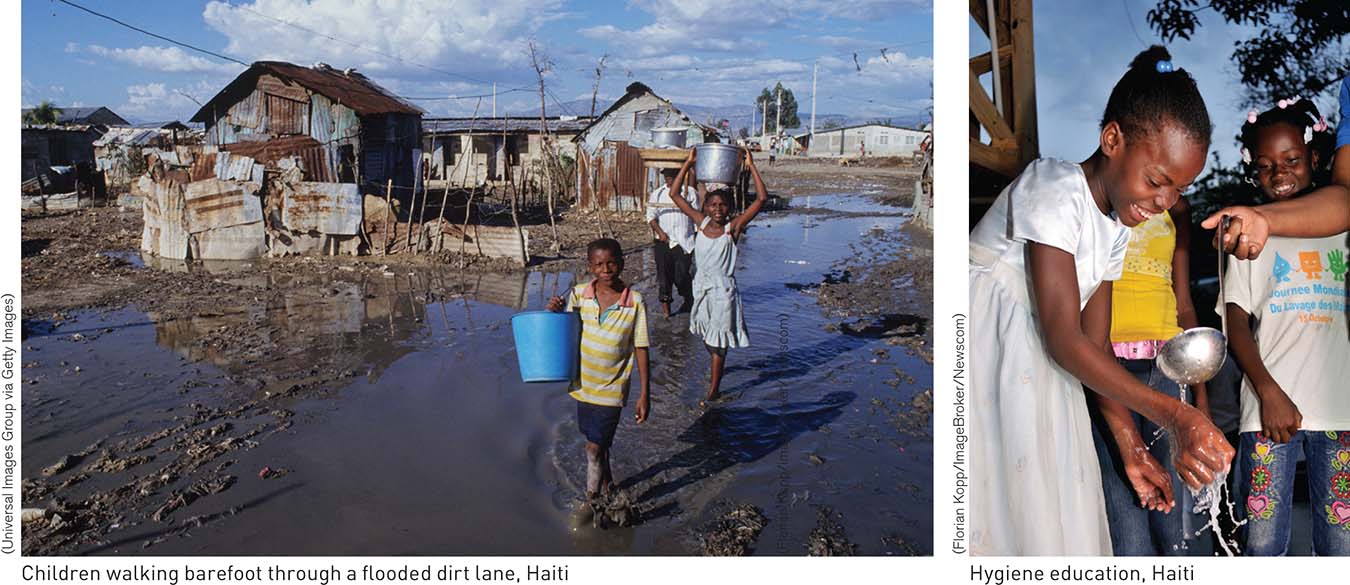11.8 Risk management involves reducing environmental hazards and controlling disease
Modern approaches to disease control include cooperation among nongovernmental organizations and governments, education, and awareness of culture and values, as well as medicines and vaccines.
Diarrheal Diseases
Diarrheal diseases are caused by a variety of bacteria, viruses, and parasites transmitted in water that is contaminated by feces. Thus, diarrheal diseases, which cause 2.5 million deaths per year, are most prevalent in countries with poor sanitation systems. According to the WHO, 88% of diarrheal diseases can be directly attributed to poor sanitation and hygiene. Young children are especially susceptible to diarrheal diseases, and half the victims of diarrheal diseases are children younger than 2 years old.
Reducing or eliminating diarrheal diseases hinges on better conservation of drinking water and management of waste. Improved water supplies can reduce diarrhea cases by 21%, while better sanitation can reduce them by 37.5%. Simply providing access to a latrine reduced incidence of diarrhea by 24% among children under 5 years of age in Lesotho, South Africa.
Ending the Bushmeat Trade
In remote villages and logging camps in Africa and elsewhere, locals continue to hunt and eat wildlife, including fruit bats, gorillas, and porcupines, that may harbor deadly viruses such as Ebola. Although many people turn to bushmeat and wild game because it is a cheap and readily available source of protein, it also plays a cultural role in some societies; this has led to a rampant national, and sometimes international, trade in bushmeat.
At John F. Kennedy airport in New York, U.S. customs agents frequently confiscate bushmeat that African nationals have brought into the country for friends and relatives. Some of these wild species are endangered or already protected, thanks to local laws and international treaties; but one of the best ways to reduce the probability of zoonotic outbreaks is through public health campaigns that emphasize the dangers of harvesting certain animals. In addition, ensuring food security among rural populations will also go a long way toward reducing reliance on bushmeat.
Malaria Control
Most attempts to control malaria, primarily by eradicating mosquitoes, have not been sustainable. Health workers have long recognized that environmental changes can impact mosquito populations and the spread of malaria. Dams and irrigation projects provide breeding grounds for mosquitoes and reducing standing water is critical to limiting their populations. Attacking the disease requires a two-
One of the most promising approaches to reducing rates of malaria infection, especially of young children and pregnant women, combines insecticide-

How would improving living conditions around the world reduce mortality from infectious diseases?


Both historic attempts to control malaria by widespread spraying of mosquito populations and using protective mosquito nets have employed pesticides. What are the differences between the two approaches?
The research on the effectiveness of insecticide-


Why are the numbers in Figure 11.20 expressed as numbers per 1,000 and per 100,000 persons at risk instead of as total numbers?
Tuberculosis
Tuberculosis (TB) is a bacterial infection that usually attacks the lungs. Cases of TB occur throughout the world, but it is most prevalent in sub-

One program receiving one of the widest applications is the directly observed treatment system, or DOTS, of the WHO. The centerpiece of the DOTS therapy is that patients diagnosed with TB take the treatment while being directly observed by trained personnel over the 6 to 8 months generally required for effective treatment. Direct observation ensures that all treatments are administered, thereby maximizing the chance for a successful cure while minimizing the risk of incomplete treatment, which runs the risk of producing antibiotic-
The DOTS system of treating TB combines the advantage of low expense with effectiveness. As a result, estimates by the WHO indicate that DOTS treatment prevented approximately 20 million deaths between 1995 and 2013. However, the DOTS treatment is effective only against strains of TB that are not drug resistant. Treating cases of multi-
A broad partnership of organizations has been formed to combat these much more difficult forms of TB on a global scale. The partnership involves several governmental and nongovernmental organizations, including (again) the Bill & Melinda Gates Foundation, which has been one of the largest nongovernmental contributors to programs aimed at combating TB. For example, the foundation donated over $112 million in 2011 to support development of better tools for addressing the global TB epidemic, including shorter and simpler treatments, new and improved vaccines, and better diagnostic tools. The foundation works as an advocate for wider access and reduced TB treatment costs around the world.
Think About It
How might cooperation between private and governmental organizations make work on disease prevention and control logistically easier?
What are some factors that make addressing a biological hazard, such as malaria, fundamentally different from addressing a chemical hazard, such as lead?
How might focusing on houses and sleeping areas for mosquito control reduce selection on mosquito populations for pesticide resistance?